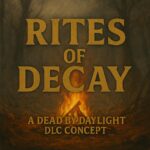There are songs that whisper.
There are songs that bleed.
And then there are songs that remember.
“Daughters of the Dust” was born from that ancient ache, the echo of women who were silenced, burned, buried, and yet never truly gone. It’s a song wrapped in smoke and salt, written for the ones whose stories were erased but whose names still hum beneath our feet.
Rooted in the traditions of dark folk and occult Americana, this piece is less a performance and more a resurrection. Every verse unearths a layer of history, mothers who spoke in roots and smoke, daughters who learned to heal, fight, and curse when the world offered no mercy. It’s an anthem of endurance, rebellion, and reverence for the power of bloodline and bone memory.
🕯️ The Meaning Behind the Song
When I wrote “Daughters of the Dust,” I wanted to create something that felt ancient and alive, like an inherited spell sung in candlelight. It’s about the legacy of women who were never allowed to tell their stories, healers, midwives, witches, and wanderers.
Each line was meant to sound like a heartbeat beneath the soil:
“They gave us dirt, we gave them roots.
They forged us chains, we bore strange fruits.”
The song speaks to how suffering can become creation — how curses can become incantations. It’s a reclamation of shame turned sacred. A reminder that resilience itself is magic.
🌾 The Sound of Dust and Memory
Musically, this track lives between folk hymn and funeral march.
- The rhythm carries the pulse of a slow ritual.
- The harmonies feel like ghostly voices joining in from beyond the veil.
- The lyrics move like an invocation — chanting, confessing, and ultimately transcending.
The chant section (“Salt on the windows, Wormwood in tea…”) was written as a nod to real folk magic practices — the quiet rituals that women performed to protect their homes, heal their families, and preserve a sense of power in secret.
🌙 Why It Matters
“Daughters of the Dust” is for every soul who’s ever been told to stay quiet, to stay small.
It’s for the ones who remember the fire even when no flames were lit.
This isn’t a song of victimhood, it’s a song of inheritance.
It’s saying: We are still here. We’ve survived the gallows, the crosses, the silence , and still, we sing.
In the end, it’s not just about witches. It’s about womanhood, ancestry, and the beauty of surviving the dust, and blooming from it.
🖤 Closing Words
When the final whispered line fades —
(“We were daughters… now we are the wind…”)
— it’s a spell closing. A promise that the story continues, even if it must be sung through the dirt.
We are the daughters.
We are the dust.
And we are still here.



